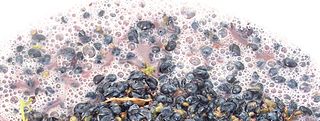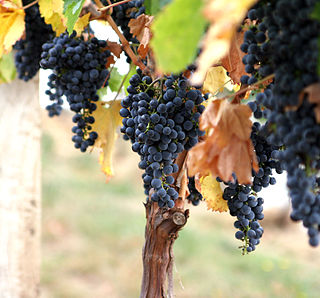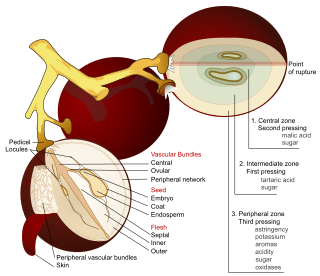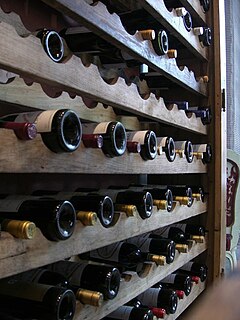Related Research Articles

Syrah, also known as Shiraz, is a dark-skinned grape variety grown throughout the world and used primarily to produce red wine. In 1999, Syrah was found to be the offspring of two obscure grapes from southeastern France, Dureza and Mondeuse Blanche. Syrah should not be confused with Petite Sirah, a cross of Syrah with Peloursin dating from 1880.
Pinot gris, pinot grigio or Grauburgunder is a white wine grape variety of the species Vitis vinifera. Thought to be a mutant clone of the pinot noir variety, it normally has a grayish-blue fruit, accounting for its name but the grapes can have a brownish pink to black and even white appearance. The word pinot could have been given to it because the grapes grow in small pine cone-shaped clusters. The wines produced from this grape also vary in color from a deep golden yellow to copper and even a light shade of pink, and it is one of the more popular grapes for skin-contact wine.

Late harvest wine is wine made from grapes left on the vine longer than usual. Late harvest is usually an indication of a sweet dessert wine, such as late harvest Riesling. Late harvest grapes are often more similar to raisins, but have been naturally dehydrated while on the vine.

Oak is used in winemaking to vary the color, flavor, tannin profile and texture of wine. It can be introduced in the form of a barrel during the fermentation or aging periods, or as free-floating chips or staves added to wine fermented in a vessel like stainless steel. Oak barrels can impart other qualities to wine through evaporation and low level exposure to oxygen.

Chaptalization is the process of adding sugar to unfermented grape must in order to increase the alcohol content after fermentation. The technique is named after its developer, the French chemist Jean-Antoine-Claude Chaptal. This process is not intended to make the wine sweeter, but rather to provide more sugar for the yeast to ferment into alcohol.

Aligoté is a white grape used to make dry white wines, especially in the Burgundy region of France where it was first recorded in the 18th century. Since it is tolerant to cold, this variety is also cultivated in Eastern European countries. In 2004, it was the 22nd most planted vine variety in the world at 45,000 hectares.

A decanter is a vessel that is used to hold the decantation of a liquid which may contain sediment. Decanters, which have a varied shape and design, have been traditionally made from glass or crystal. Their volume is usually equivalent to one standard bottle of wine.

Jancis Mary RobinsonOBE, ComMA, MW is a British wine critic, journalist and wine writer. She currently writes a weekly column for the Financial Times, and writes for her website JancisRobinson.com, updated daily. She also provides advice for the wine cellar of Queen Elizabeth II.

Montepulciano is a red Italian wine grape variety that is most noted for being the primary grape behind the DOCG wines Offida Rosso, Montepulciano d'Abruzzo, Montepulciano d'Abruzzo Colline Teramane, Rosso Conero and the DOC wine Rosso Piceno Superiore.

The process of fermentation in winemaking turns grape juice into an alcoholic beverage. During fermentation, yeasts transform sugars present in the juice into ethanol and carbon dioxide. In winemaking, the temperature and speed of fermentation are important considerations as well as the levels of oxygen present in the must at the start of the fermentation. The risk of stuck fermentation and the development of several wine faults can also occur during this stage, which can last anywhere from 5 to 14 days for primary fermentation and potentially another 5 to 10 days for a secondary fermentation. Fermentation may be done in stainless steel tanks, which is common with many white wines like Riesling, in an open wooden vat, inside a wine barrel and inside the wine bottle itself as in the production of many sparkling wines.

The harvesting of wine grapes (Vintage) is one of the most crucial steps in the process of wine-making. The time of harvest is determined primarily by the ripeness of the grape as measured by sugar, acid and tannin levels with winemakers basing their decision to pick based on the style of wine they wish to produce. The weather can also shape the timetable of harvesting with the threat of heat, rain, hail, and frost which can damage the grapes and bring about various vine diseases. In addition to determining the time of the harvest, winemakers and vineyard owners must also determine whether to use hand pickers or mechanical harvesters. The harvest season typically falls between August & October in the Northern Hemisphere and February & April in the Southern Hemisphere. With various climate conditions, grape varieties, and wine styles the harvesting of grapes could happen in every month of the calendar year somewhere in the world. In the New World it is often referred to as the crush.

Cru is a wine term term used to indicate a high-quality vineyard or group of vineyards. It is a French word which is traditionally translated as "growth", as it was originally the past participle of the verb "croître". The term is often used within classifications of French wine. By implication, a wine that displays the name of its cru on its wine label is supposed to exhibit the typical characteristics of this cru. The terms Premier Cru and Grand Cru designate levels of presumed quality that are variously defined in different wine regions.

The annual growth cycle of grapevines is the process that takes place in the vineyard each year, beginning with bud break in the spring and culminating in leaf fall in autumn followed by winter dormancy. From a winemaking perspective, each step in the process plays a vital role in the development of grapes with ideal characteristics for making wine. Viticulturalists and vineyard managers monitor the effect of climate, vine disease and pests in facilitating or impeding the vine's progression from bud break, flowering, fruit set, veraison, harvesting, leaf fall and dormancy-reacting if need be with the use of viticultural practices like canopy management, irrigation, vine training and the use of agrochemicals. The stages of the annual growth cycle usually become observable within the first year of a vine's life. The amount of time spent at each stage of the growth cycle depends on a number of factors-most notably the type of climate and the characteristics of the grape variety.

Sugars in wine are at the heart of what makes winemaking possible. During the process of fermentation, sugars from wine grapes are broken down and converted by yeast into alcohol (ethanol) and carbon dioxide. Grapes accumulate sugars as they grow on the grapevine through the translocation of sucrose molecules that are produced by photosynthesis from the leaves. During ripening the sucrose molecules are hydrolyzed (separated) by the enzyme invertase into glucose and fructose. By the time of harvest, between 15 and 25% of the grape will be composed of simple sugars. Both glucose and fructose are six-carbon sugars but three-, four-, five- and seven-carbon sugars are also present in the grape. Not all sugars are fermentable, with sugars like the five-carbon arabinose, rhamnose and xylose still being present in the wine after fermentation. Very high sugar content will effectively kill the yeast once a certain (high) alcohol content is reached. For these reasons, no wine is ever fermented completely "dry". Sugar's role in dictating the final alcohol content of the wine sometimes encourages winemakers to add sugar during winemaking in a process known as chaptalization solely in order to boost the alcohol content – chaptalization does not increase the sweetness of a wine.

The acids in wine are an important component in both winemaking and the finished product of wine. They are present in both grapes and wine, having direct influences on the color, balance and taste of the wine as well as the growth and vitality of yeast during fermentation and protecting the wine from bacteria. The measure of the amount of acidity in wine is known as the “titratable acidity” or “total acidity”, which refers to the test that yields the total of all acids present, while strength of acidity is measured according to pH, with most wines having a pH between 2.9 and 3.9. Generally, the lower the pH, the higher the acidity in the wine. However, there is no direct connection between total acidity and pH. In wine tasting, the term “acidity” refers to the fresh, tart and sour attributes of the wine which are evaluated in relation to how well the acidity balances out the sweetness and bitter components of the wine such as tannins. Three primary acids are found in wine grapes: tartaric, malic, and citric acids. During the course of winemaking and in the finished wines, acetic, butyric, lactic, and succinic acids can play significant roles. Most of the acids involved with wine are fixed acids with the notable exception of acetic acid, mostly found in vinegar, which is volatile and can contribute to the wine fault known as volatile acidity. Sometimes, additional acids, such as ascorbic, sorbic and sulfurous acids, are used in winemaking.
Vilana is a white Greek wine grape variety planted primarily in Crete. The grape is a difficult one to cultivate and produces delicate wines rarely seen outside Greece.
Limnio (LIM-nee-oh) is a red Greek wine grape variety that is indigenous to the Greek island of Lemnos. The grape has had a long history of wine production that may extend back to Ancient Greece with wine historians widely believing it was the grape variety, Lemnia, that was described by Aristotle as producing the famous red Lemnian wine. According to wine expert Oz Clarke, Limnio is "One of Greece's most important red vines."

In winemaking, clarification and stabilization are the processes by which insoluble matter suspended in the wine is removed before bottling. This matter may include dead yeast cells (lees), bacteria, tartrates, proteins, pectins, various tannins and other phenolic compounds, as well as pieces of grape skin, pulp, stems and gums. Clarification and stabilization may involve fining, filtration, centrifugation, flotation, refrigeration, pasteurization, and/or barrel maturation and racking.

Storage of wine is an important consideration for wine that is being kept for long-term aging. While most wine is consumed within 24 hours of purchase, fine wines are often set aside for long-term storage. Wine is one of the few commodities that can improve in flavour and value with age, but it can also rapidly deteriorate if kept in inadequate conditions.

Olmo grapes are wine and table grape varieties produced by University of California, Davis viticulturist Dr. Harold Olmo. Over the course of his nearly 50-year career, Dr. Olmo bred a wide variety of both grapes by means of both crossing varieties from the same species or creating hybrid grapes from cultivars of different Vitis species.
References
- ↑ J. Robinson Jancis Robinson's Wine Course Third Edition pg 140 Abbeville Press 2003 ISBN 0-7892-0883-0